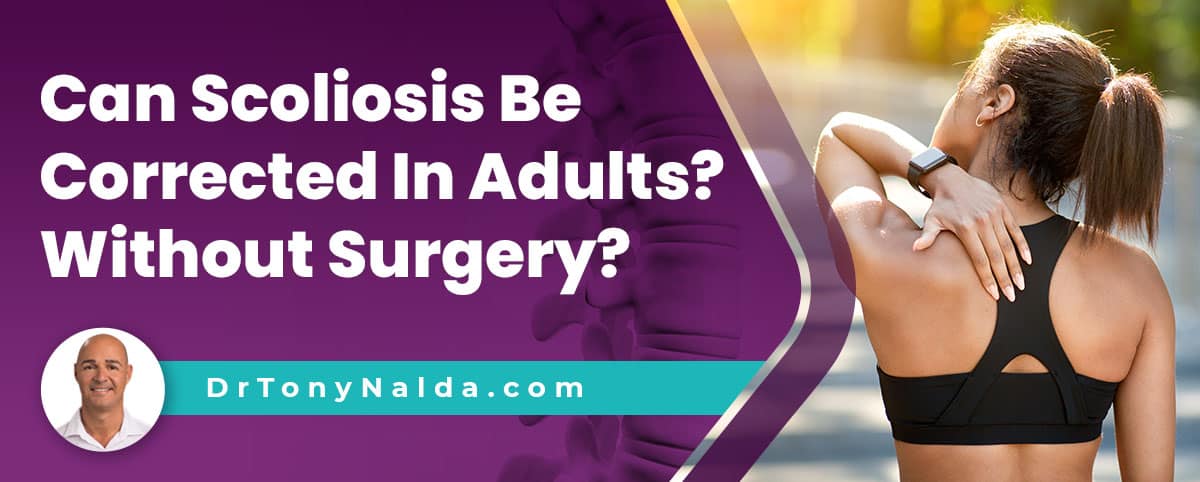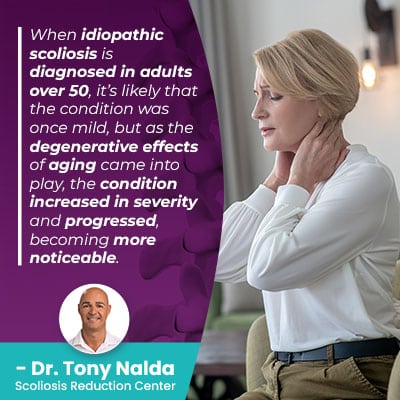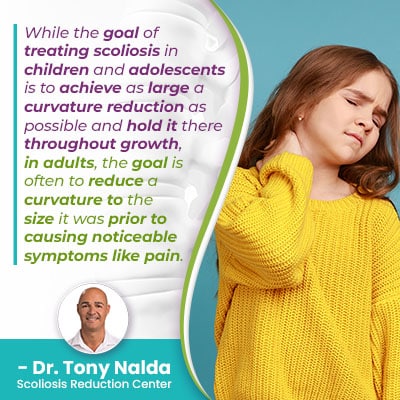Can Scoliosis Be Corrected In Adults? Without Surgery?

While scoliosis is more commonly diagnosed in children and adolescents, adults can develop it too, and the rates of scoliosis actually increase with age. While the treatment focus can shift when treating adult scoliosis, proactive treatment still has the potential to help with pain management, curvature reductions, and increased core strength, so the spine is optimally supported and stabilized.
Scoliosis can’t be corrected, as in cured, in any age group; scoliosis is an incurable, progressive condition. Proactive treatment, however, can help counteract the condition’s progressive nature by strengthening the spine and its surrounding muscles and reducing scoliosis on a structural level.
Before getting to the specifics of correcting scoliosis in adults, let’s first talk generally about the condition’s progressive nature, as progression is a key factor in treating scoliosis.
Table of Contents
Scoliosis and Progression
A person diagnosed with scoliosis has an unnatural sideways spinal curve with rotation and a minimum Cobb angle measurement of 10 degrees.
A patient’s Cobb angle is measured during X-ray and places a condition on its severity scale of mild, moderate, severe, or very severe.
Part of the reason scoliosis is often deemed complex to treat is because not only does it develop across a wide severity spectrum, necessitating the customization of treatment plans, but there are also multiple types of scoliosis, each with its own unique characteristics and treatment needs.
The most common type of scoliosis is adolescent idiopathic scoliosis (AIS), diagnosed between the ages of 10 and 18, and this age group is at risk for rapid-phase progression.
Scoliosis is progressive, meaning it has it in its very nature to worsen over time, especially if left untreated or not treated proactively.
Now, in idiopathic scoliosis, the idiopathic designation means not clearly associated with a single causative source, but while we don’t fully understand its etiology, we know what makes it progress: growth and development.
So as you can see, children and adolescents are at the highest risk for rapid progression because they are still growing, but adults, however, who have reached skeletal maturity have that significant progressive trigger removed.
It’s important to understand, when it comes to correcting scoliosis in adults, that even though the progressive rate of scoliosis tends to slow once growth is complete, adults still progress over time. The cumulative effect can be a significant curvature increase over time.
Correcting scoliosis in adults can be challenging, especially when arthritis complicates the condition and leads to issues like leg collapse.
In addition, the actual rates of scoliosis increase with age, so let’s talk about the two main condition types affecting adults: idiopathic and degenerative.
Adult Scoliosis and Scoliosis in Adults over 50
For many years, scoliosis was regarded as a child and adolescent condition, but studies have since shown that the prevalence of scoliosis actually increases with age.
The rate of scoliosis in adolescents is generally estimated at around 2 to 4 percent, while studies on the incidence of scoliosis in adults show rates of between 12 and 20 percent, and in healthy adults over the age of 50, scoliosis, to varying degrees, was detected in 68 percent.
The most common type of scoliosis to affect adults is idiopathic.
Adult Idiopathic Scoliosis
The most prevalent type of scoliosis in adults is idiopathic scoliosis. In these cases, scoliosis has not developed anew in adulthood but is instead an extension of AIS cases that were left undiagnosed and untreated through adolescence.
It might seem difficult to imagine that so many cases of AIS could go unnoticed for so long, but the reality is that scoliosis isn’t known to cause noticeable functional deficits, nor is it known to be painful in children and adolescents, so early detection can be a challenge.
The reason scoliosis isn’t commonly painful in children and adolescents is that it doesn’t become a compressive condition until adulthood.
While a spine is still growing, it’s experiencing a constant upward lengthening motion, which counteracts the compressive force of the curvature, and it’s compression of the spine and its surrounding muscles and nerves that cause the majority of condition-related pain.
When an adolescent reaches skeletal maturity, the condition becomes compressive and can cause back pain or radicular pain felt throughout the body. And pain is the number-one symptom of scoliosis symptom in adults. The postural deviation is the main symptom in children and adolescents, but even those changes can be subtle and difficult for anyone other than a scoliosis expert to detect.
 When idiopathic scoliosis is diagnosed in adults over 50, it’s likely that the condition was once mild, but as the degenerative effects of aging came into play, the condition increased in severity and progressed, becoming more noticeable.
When idiopathic scoliosis is diagnosed in adults over 50, it’s likely that the condition was once mild, but as the degenerative effects of aging came into play, the condition increased in severity and progressed, becoming more noticeable.
The unfortunate reality is that had these patients received a diagnosis and treatment during adolescence, and their spines would be in far better condition than by the time they come to see me for a diagnosis/treatment in adulthood; however, it’s never too late for treatment, and improvements can also be worked towards, regardless of age.
Through a series of gentle and precise chiropractic adjustments, I can work towards repositioning the most-tilted vertebrae back into alignment with the rest of the spine, and once I see those structural results, I can shift the focus to increasing core strength so the spine’s surrounding muscles are supporting it and stabilizing it.
After idiopathic scoliosis, the next most common type of scoliosis to affect adults is degenerative scoliosis.
Degenerative Scoliosis
Degenerative scoliosis is most commonly diagnosed in adults over the age of 40 and is associated with the natural age-related effects of spinal degeneration.
Most often, it’s the spine’s intervertebral discs that are the first spinal structures to start to deteriorate, and as the discs provide the spine with structure, cushioning between adjacent vertebrae, facilitate flexible movement, and act as the spine’s shock absorbers, their deterioration can affect the spine’s overall health and function in multiple ways.
As the discs degenerate, they can become desiccated, bulging, or herniated: all of which are risk factors for degenerative scoliosis.
When the spine is degenerating, it’s less capable of maintaining its natural curvatures and alignment and is more likely to develop an unnatural spinal curve.
Degenerative scoliosis is also more common in females than males, and this is related to hormone and bone-density changes caused by menopause.
So now that we know the two main types of scoliosis to affect adults, and their causes, the most relevant question is how to treat them moving forward.
Scoliosis Treatment for Adults
As mentioned, it’s never too late to start scoliosis treatment; in fact, the best time to start treatment is always now.
While the focus of treatment can shift when it comes to adult scoliosis, such as including pain management that’s not generally necessary in younger patients, goals still include curvature reduction and increasing spinal support and stabilization.
The intense level of monitoring is not as necessary in adults because the big trigger of growth has been removed, but keep in mind, even if a condition is progressing incrementally at a rate of one degree a year, over ten years, that 10-degree increase can make a big difference.
 While the goal of treating scoliosis in children and adolescents is to achieve as large a curvature reduction as possible and hold it there during growth, in adults, the goal is often to reduce a curvature to the size it was prior to causing noticeable symptoms like pain.
While the goal of treating scoliosis in children and adolescents is to achieve as large a curvature reduction as possible and hold it there during growth, in adults, the goal is often to reduce a curvature to the size it was prior to causing noticeable symptoms like pain.
Many adult patients often wonder what is the best way to treat scoliosis and the answer lies in exploring non-surgical methods on how to fix scoliosis, manage scoliosis curves, and learn how to cure scoliosis through tailored treatments and therapies.
For adults with scoliosis, seeking alternatives to spinal surgery becomes crucial, and while there's no cure for scoliosis, new treatment options offer hope for correcting spine curvature, especially in cases of mild scoliosis, providing relief to scoliosis patients without the need for invasive spinal surgery.
So while a reduction is always a goal with adult scoliosis treatment, the focus is on reducing it back to a certain size while also increasing spinal support and stabilizing the spine to prevent further degeneration and preserve as much natural function as possible.
Now, to clearly answer the question, can scoliosis be corrected in adults, I first want to say that the term corrected can mean different things to different people; for many, corrected means cured, but in the context of a progressive condition like scoliosis, corrected means achieving corrective results, which is different.
Corrective results means reducing a curve and increasing core strength, so the spine is optimally supported/stabilized, but as an incurable, progressive condition, work will still have to be done to sustain those corrective results.
Here at the Scoliosis Reduction Center, I tend to use shorter bursts of intense treatment to reduce scoliosis, then focus on stabilizing the spine, and these achievements provide sustainable pain management because the underlying cause of the pain (the structural nature of scoliosis) is being addressed.
By integrating multiple condition-specific treatment disciplines like chiropractic care, in-office therapy, custom-prescribed home exercises, and corrective bracing when necessary, I can impact the condition structurally and increase core strength so the spine’s surrounding muscles can provide it with optimal support and stabilization.
Often, treatment is spread out slowly over time in the treatment of adult scoliosis, but this doesn't produce the same type of results and can lead to a surgical recommendation; the reality is that many cases of adult scoliosis can be treated non-surgically.
While scoliosis can often be managed in adults without surgery through targeted exercises and physical therapy, it's important to be aware of scoliosis exercises to avoid and physical activity that may exacerbate the condition.
Can Scoliosis be Corrected in Adults?
So to clearly answer the question, can scoliosis be corrected in adults? I’d like to share one of my adult patient’s stories of how they went from having mild adolescent idiopathic scoliosis to adult idiopathic scoliosis that was progressing quickly, even after skeletal maturity was reached.
Amber’s scoliosis treatment success story highlights the difference between a watch-and-wait approach and a proactive conservative approach, while also showing how a mild case of adolescent idiopathic scoliosis can become more serious and problematic later in life, particularly after an injury.
In addition, Amber’s story also shows the danger of following common advice given to adolescents: “You’ve stopped growing now, so you don’t have to worry about your scoliosis anymore.”
Have a listen to the retelling of Amber’s scoliosis treatment success story, in her own words, to learn how we achieved a curvature reduction of 27.7 degrees to 17.7 degrees; her story is a positive example of how scoliosis treatment for adults without surgery is possible.
Many people often wonder, "Can you fix scoliosis?" especially when treating adult onset scoliosis. The journey on how to fix scoliosis can be complex, as various factors come into play, including the severity and location of the spinal curvature. For instance, congenital scoliosis, a type of scoliosis present at birth, differs from the type that develops in the lumbar spine or during adulthood.
Scoliosis can often be managed and its symptoms alleviated in adults without surgery through targeted spine stretches and scoliosis stretches designed to strengthen muscles and straighten the spine.
As individuals age, concerns arise about whether scoliosis gets worse, and indeed, in some cases, spinal deformities can intensify. Answering the question, "How do you treat scoliosis?" involves exploring a range of interventions from physical therapy to surgical procedures. For those with severe scoliosis, spinal fusion surgery might be recommended as a solution. While scoliosis is a persistent spinal deformity, its effects can be managed, but whether it's entirely curable often depends on the specific case and the treatment applied.
The thoracolumbar spine is an intricate region where the thoracic (mid-back) and lumbar (lower back) vertebrae converge, and it's not uncommon for scoliosis, or an abnormal sideways curvature of the spine, to manifest in this area.
One specific type of scoliosis that affects the lumbar spine is levoscoliosis, where the spine curves to the left. Scoliosis pain can arise from various causes, including muscle fatigue, spinal misalignment, or pressure on the spinal nerves. Furthermore, scoliosis treatment often varies depending on the age of the patient; for instance, children and adults might wear braces to prevent the progression of the curvature, while adults might require physical therapy or even surgery.
It's also important to recognize the main types of scoliosis curvatures: thoracic, lumbar, and thoracolumbar, each referring to the region of the spine affected by the abnormal curve. By understanding these different facets of scoliosis, one can better navigate the complexities of diagnosis, management, and treatment.
Correcting scoliosis in adults can be challenging, especially in cases of severe scoliosis, which often presents with pronounced symptoms and chronic pain. While what causes scoliosis in adults can vary, ranging from congenital factors to degenerative changes, the approach to treatment often depends on the individual's age and the severity of the condition.
Non-surgical scoliosis treatment options for adults, though often limited compared to those for younger patients, may include physical therapy, pain management techniques, and bracing. These methods aim to alleviate scoliosis-related symptoms such as pain and fatigue. However, it's important to note that while these treatments can help manage symptoms and improve quality of life, they may not fully correct the curvature in adults, particularly in severe cases.
Conclusion
When it comes to adult scoliosis, the two most common types are idiopathic and degenerative.
Scoliosis can be corrected in adults, without surgery, through a conservative treatment approach that values being proactive and starting treatment as close to the time of diagnosis as possible.
The prevalence of idiopathic scoliosis in adults reveals both the challenge of achieving early detection in adolescence and what can happen when scoliosis is left undiagnosed and untreated: it’s allowed to progress unchecked until the condition starts to produce noticeable symptoms once becoming compressive in adulthood.
Degenerative scoliosis is related to natural age-related degenerative changes, which is why treatment focuses on preventing further deterioration and preserving as much disc function as possible.
While I’m always working towards a curvature reduction on a structural level, with adult scoliosis, oftentimes the focus is more on reducing a curve back to where it was prior to causing noticeable symptoms like pain, and then working to stabilize the spine to sustain those corrective results.
While spinal fusion still has a place in the treatment of adult scoliosis, the reality is that it’s a costly and invasive procedure with heavy risks and potential side effects, and those risks only increase with age.
While early detection can increase the chances of treatment success, it’s never too late to start adult scoliosis treatment that prioritizes curvature reductions, increasing core strength, and stabilizing the spine to prevent further damage and provide sustainable long-term pain relief without surgery.
Dr. Tony Nalda
DOCTOR OF CHIROPRACTIC
After receiving an undergraduate degree in psychology and his Doctorate of Chiropractic from Life University, Dr. Nalda settled in Celebration, Florida and proceeded to build one of Central Florida’s most successful chiropractic clinics.
His experience with patients suffering from scoliosis, and the confusion and frustration they faced, led him to seek a specialty in scoliosis care. In 2006 he completed his Intensive Care Certification from CLEAR Institute, a leading scoliosis educational and certification center.
About Dr. Tony Nalda
 Ready to explore scoliosis treatment? Contact Us Now
Ready to explore scoliosis treatment? Contact Us Now





